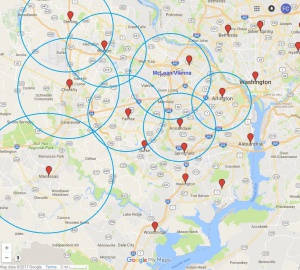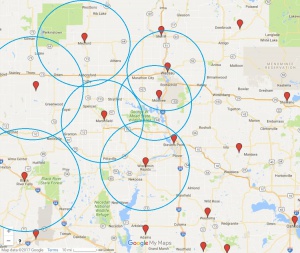Difference between revisions of "Team Wikis:Point-Centered Groups"
| [checked revision] | [checked revision] |
Alisonkamat (talk | contribs) (Created page with "==Point-centered groups== thumbnail|Urban area with smaller coverage areas for groups file:WImapCircles.jpg|thumbnail|Rural area with larger cove...") |
Alisonkamat (talk | contribs) (added population criteria) |
||
| (3 intermediate revisions by the same user not shown) | |||
| Line 3: | Line 3: | ||
[[file:WImapCircles.jpg|thumbnail|Rural area with larger coverage areas]] | [[file:WImapCircles.jpg|thumbnail|Rural area with larger coverage areas]] | ||
| − | Rather than define the boundaries of a group, we view groups as points on a map. A group's coverage area can be viewed as a circle with a radius of 10-20 miles, depending on population density and availability of transportation. The | + | Rather than define the boundaries of a group, we view groups as points on a map. A group's coverage area can be viewed as a circle with a radius of 10-20 miles, depending on population density and availability of transportation. The circle would overlap with neighbor groups on the edges |
| − | The group coverage area would be much smaller in highly congested metropolitan areas where people primarily get around by walking and much bigger in rural areas. As a general rule, a group is considered viable from a proximity standpoint if travel time (driving, walking or mass transit) to the nearest group(s) exceeds | + | The group coverage area would be much smaller in highly congested metropolitan areas where people primarily get around by walking and much bigger in rural areas. As a general rule, a group is considered viable from a proximity standpoint if travel time by the quickest means (driving, walking or mass transit) to the nearest group(s) exceeds 20 minutes. Check distance using the directions icon on Google Maps and choose the appropriate transporation option. The local community must also have a population of at least 10,000 to be considered viable. |
Using the point-centered group approach it is not necessary to define what towns a group covers. It is understood that a group covers all nearby towns that do not meet the viability criteria for starting a new group. There is no need to change the name of the group to the applicant's town. [[Group_Naming_Conventions|Click here for group naming conventions]] | Using the point-centered group approach it is not necessary to define what towns a group covers. It is understood that a group covers all nearby towns that do not meet the viability criteria for starting a new group. There is no need to change the name of the group to the applicant's town. [[Group_Naming_Conventions|Click here for group naming conventions]] | ||
Revision as of 20:38, 14 August 2019
Point-centered groups
Rather than define the boundaries of a group, we view groups as points on a map. A group's coverage area can be viewed as a circle with a radius of 10-20 miles, depending on population density and availability of transportation. The circle would overlap with neighbor groups on the edges
The group coverage area would be much smaller in highly congested metropolitan areas where people primarily get around by walking and much bigger in rural areas. As a general rule, a group is considered viable from a proximity standpoint if travel time by the quickest means (driving, walking or mass transit) to the nearest group(s) exceeds 20 minutes. Check distance using the directions icon on Google Maps and choose the appropriate transporation option. The local community must also have a population of at least 10,000 to be considered viable.
Using the point-centered group approach it is not necessary to define what towns a group covers. It is understood that a group covers all nearby towns that do not meet the viability criteria for starting a new group. There is no need to change the name of the group to the applicant's town. Click here for group naming conventions

